“Miswak” Based Green Synthesis of Silver Nanoparticles: Evaluation and Comparison of Their Microbicidal Activities with the Chemical Synthesis
Abstract
:1. Introduction
2. Results and Discussion
2.1. UV-Vis Spectral Analysis
2.2. FT-IR Analysis
2.3. Powder X-ray Diffraction
2.4. TEM and EDX Analysis
2.5. XRD, SEM, and EDX Analysis of S. persica L. Root Extract
2.6. UV-Vis and XRD Analysis of Chemically Synthesized Ag-NPs
2.7. Microbicidal Activity of Silver Nanoparticles
3. Experimental Section
3.1. Materials
3.2. Methods
3.2.1. Preparation of S. persica L. RE
3.2.2. Green Synthesis of Silver Nanoparticles
3.2.3. Chemical Synthesis of Silver NPs
3.3. Methods of Characterization
3.3.1. UV-Vis Spectroscopy
3.3.2. Transmission Electron Microscopy (TEM)
3.3.3. X-ray Diffraction (XRD)
3.3.4. Fourier Transform Infrared Spectrometer (FT-IR)
3.4. Microbicial Activity
4. Conclusions
Acknowledgments
Author Contributions
Conflicts of Interest
References
- Iravani, S. Green synthesis of metal nanoparticles using plants. Green Chem. 2011, 13, 2638–2650. [Google Scholar] [CrossRef]
- Makarov, V.; Love, A.; Sinitsyna, O.; Makarova, S.; Yaminsky, I.; Taliansky, M.; Kalinina, N. “Green” nanotechnologies: Synthesis of metal nanoparticles using plants. Acta Nat. 2014, 6, 35–44. [Google Scholar]
- Thakkar, K.N.; Mhatre, S.S.; Parikh, R.Y. Biological synthesis of metallic nanoparticles. Nanomed. Nanotechnol. Biol. Med. 2010, 6, 257–262. [Google Scholar] [CrossRef]
- Dahl, J.A.; Maddux, B.L.; Hutchison, J.E. Toward greener nanosynthesis. Chem. Rev. 2007, 107, 2228–2269. [Google Scholar] [CrossRef]
- Anastas, P.; Eghbali, N. Green chemistry: Principles and practice. Chem. Soc. Rev. 2010, 39, 301–312. [Google Scholar] [CrossRef]
- Hebbalalu, D.; Lalley, J.; Nadagouda, M.N.; Varma, R.S. Greener techniques for the synthesis of silver nanoparticles using plant extracts, enzymes, bacteria, biodegradable polymers, and microwaves. ACS Sustain. Chem. Eng. 2013, 1, 703–712. [Google Scholar] [CrossRef]
- Kalathil, S.; Lee, J.; Cho, M.H. Electrochemically active biofilm-mediated synthesis of silver nanoparticles in water. Green Chem. 2011, 13, 1482–1485. [Google Scholar] [CrossRef]
- Zaarour, M.; El Roz, M.; Dong, B.; Retoux, R.; Aad, R.; Cardin, J.; Dufour, C.; Gourbilleau, F.; Gilson, J.-P.; Mintova, S. Photochemical preparation of silver nanoparticles supported on zeolite crystals. Langmuir 2014, 30, 6250–6256. [Google Scholar] [CrossRef]
- Farooq Adil, S.; Mohamed, E.A.; Mujeeb, K.; Abdulrahman, A.-W.; Siddiqui, M.R.H.; Luis, M.L.-M. Biogenic synthesis of metallic nanoparticles and prospects toward green chemistry. Dalton Trans. 2015, 44, 9709–9717. [Google Scholar] [CrossRef]
- Otari, S.; Patil, R.; Waghmare, S.; Ghosh, S.; Pawar, S. A novel microbial synthesis of catalytically active Ag-alginate biohydrogel and its antimicrobial activity. Dalton Trans. 2013, 42, 9966–9975. [Google Scholar] [CrossRef]
- Jain, N.; Bhargava, A.; Majumdar, S.; Tarafdar, J.; Panwar, J. Extracellular biosynthesis and characterization of silver nanoparticles using aspergillus flavus NJP08: A mechanism perspective. Nanoscale 2011, 3, 635–641. [Google Scholar] [CrossRef]
- Borase, H.P.; Salunke, B.K.; Salunkhe, R.B.; Patil, C.D.; Hallsworth, J.E.; Kim, B.S.; Patil, S.V. Plant extract: A promising biomatrix for ecofriendly, controlled synthesis of silver nanoparticles. Appl. Biochem. Biotechnol. 2014, 173, 1–29. [Google Scholar] [CrossRef]
- Abbasi, E.; Milani, M.; Fekri Aval, S.; Kouhi, M.; Akbarzadeh, A.; Tayefi Nasrabadi, H.; Nikasa, P.; Joo, S.W.; Hanifehpour, Y.; Nejati-Koshki, K.; et al. Silver nanoparticles: Synthesis methods, bio-applications and properties. Crit. Rev. Microbiol. 2016, 42, 173–180. [Google Scholar] [CrossRef]
- Shen, W.; Zhang, X.; Huang, Q.; Xu, Q.; Song, W. Preparation of solid silver nanoparticles for inkjet printed flexible electronics with high conductivity. Nanoscale 2014, 6, 1622–1628. [Google Scholar] [CrossRef]
- Gavanji, S.; Mohabatkar, H.; Baghshahi, H.; Zarrabi, A. Bioinformatics prediction of interaction silver nanoparticles on the disulfide bonds of HIV-1 Gp120 protein. Int. J. Sci. Res. Knowl. 2014, 2, 67–74. [Google Scholar] [CrossRef]
- Priya, S.; Murugan, K.; Priya, A.; Dinesh, D.; Panneerselvam, C.; Devi, G.D. Green synthesis of silver nanoparticles using calotropis gigantea and their potential mosquito larvicidal property. J. Pure Appl. Zool. 2014, 2, 128–137. [Google Scholar]
- Shrivastava, S.; Bera, T.; Singh, S.K.; Singh, G.; Ramachandrarao, P.; Dash, D. Characterization of antiplatelet properties of silver nanoparticles. ACS Nano 2009, 3, 1357–1364. [Google Scholar] [CrossRef]
- Lee, H.; Yeo, S.; Jeong, S. Antibacterial effect of nanosized silver colloidal solution on textile fabrics. J. Mater. Sci. 2003, 38, 2199–2204. [Google Scholar] [CrossRef]
- Al-Hobaib, A.S.; Al-sheetan, K.M.; Shaik, M.R.; Al-Andis, N.M.; Al-Suhybani, M. Characterization and evaluation of reverse osmosis membranes modified with Ag2O nanoparticles to improve performance. Nanoscale Res. Lett. 2015, 10, 1–13. [Google Scholar] [CrossRef]
- De Moura, M.R.; Mattoso, L.H.; Zucolotto, V. Development of cellulose-based bactericidal nanocomposites containing silver nanoparticles and their use as active food packaging. J. Food Eng. 2012, 109, 520–524. [Google Scholar] [CrossRef]
- Khan, M.; Khan, M.; Adil, S.F.; Tahir, M.N.; Tremel, W.; Alkhathlan, H.Z.; Al-Warthan, A.; Siddiqui, M.R.H. Green synthesis of silver nanoparticles mediated by pulicaria glutinosa extract. Int. J. Nanomed. 2013, 8, 1507–1516. [Google Scholar]
- Valli, J.S.; Vaseeharan, B. Biosynthesis of silver nanoparticles by cissus quadrangularis extracts. Mater. Lett. 2012, 82, 171–173. [Google Scholar] [CrossRef]
- Rai, M.; Yadav, A.; Gade, A. Silver nanoparticles as a new generation of antimicrobials. Biotechnol. Adv. 2009, 27, 76–83. [Google Scholar] [CrossRef]
- Song, J.Y.; Kim, B.S. Rapid biological synthesis of silver nanoparticles using plant leaf extracts. Bioprocess Biosyst. Eng. 2009, 32, 79–84. [Google Scholar] [CrossRef]
- Mittal, A.K.; Chisti, Y.; Banerjee, U.C. Synthesis of metallic nanoparticles using plant extracts. Biotechnol. Adv. 2013, 31, 346–356. [Google Scholar] [CrossRef]
- Song, J.Y.; Jang, H.-K.; Kim, B.S. Biological synthesis of gold nanoparticles using magnolia kobus and diopyros kaki leaf extracts. Process Biochem. 2009, 44, 1133–1138. [Google Scholar] [CrossRef]
- Cure, J.; Coppel, Y.; Dammak, T.; Fazzini, P.F.; Mlayah, A.; Chaudret, B.; Fau, P. Monitoring the coordination of Amine Ligands on silver nanoparticles using NMR and SERS. Langmuir 2015, 31, 1362–1367. [Google Scholar] [CrossRef]
- Akhtar, M.S.; Panwar, J.; Yun, Y.-S. Biogenic synthesis of metallic nanoparticles by plant extracts. ACS Sustain Chem. Eng. 2013, 1, 591–602. [Google Scholar] [CrossRef]
- Gan, P.P.; Li, S.F.Y. Potential of plant as a biological factory to synthesize gold and silver nanoparticles and their applications. Rev. Environ. Sci. Bio/Technol. 2012, 11, 169–206. [Google Scholar] [CrossRef]
- McConnell, O.J.; Longley, R.E.; Koehn, F.E. The discovery of marine natural products with therapeutic potential. Biotechnology 1994, 26, 109–174. [Google Scholar]
- Ntie-Kang, F.; Njume, L.E.; Malange, Y.I.; Günther, S.; Sippl, W.; Yong, J.N. The chemistry and biological activities of natural products from northern african plant families: From taccaceae to Zygophyllaceae. Nat. Prod. Bioprospect. 2016, 6. [Google Scholar] [CrossRef]
- Al-Marri, A.H.; Khan, M.; Khan, M.; Adil, S.F.; Al-Warthan, A.; Alkhathlan, H.Z.; Tremel, W.; Labis, J.P.; Siddiqui, M.R.H.; Tahir, M.N. Pulicaria glutinosa extract: A toolbox to synthesize highly reduced graphene oxide-silver nanocomposites. Int. J. Mol. Sci. 2015, 16, 1131–1142. [Google Scholar] [CrossRef]
- Leonov, A.P.; Zheng, J.; Clogston, J.D.; Stern, S.T.; Patri, A.K.; Wei, A. Detoxification of gold nanorods by treatment with polystyrenesulfonate. ACS Nano 2008, 2, 2481–2488. [Google Scholar] [CrossRef]
- Suresh, A.K.; Pelletier, D.A.; Wang, W.; Moon, J.-W.; Gu, B.; Mortensen, N.P.; Allison, D.P.; Joy, D.C.; Phelps, T.J.; Doktycz, M.J. Silver nanocrystallites: Biofabrication using Shewanella oneidensis, and an evaluation of their comparative toxicity on Gram-negative and Gram-positive bacteria. Environ. Sci. Technol. 2010, 44, 5210–5215. [Google Scholar] [CrossRef]
- Khan, S.T.; Ahmad, J.; Siddiqui, M.A.; Ali, B.A. Coo thin nanosheets exhibit higher antimicrobial activity against tested gram-positive bacteria than gram-negative bacteria. Korean Chem. Eng. Res. 2015, 53, 565–569. [Google Scholar] [CrossRef]
- Russo, M.; Meli, A.; Sutera, A.; Gallo, G.; Martino, D.C.; Lo Meo, P.; Noto, R. Photosynthesized silver–polyaminocyclodextrin nanocomposites as promising antibacterial agents with improved activity. RSC Adv. 2016, 6, 40090–40099. [Google Scholar] [CrossRef]
- Hellstrand, E.; Lynch, I.; Andersson, A.; Drakenberg, T.; Dahlbäck, B.; Dawson, K.A.; Linse, S.; Cedervall, T. Complete high-density lipoproteins in nanoparticle corona. FEBS J. 2009, 276, 3372–3381. [Google Scholar] [CrossRef]
- Padalia, H.; Moteriya, P.; Chanda, S. Green synthesis of silver nanoparticles from marigold flower and its synergistic antimicrobial potential. Arabian J. Chem. 2015, 8, 732–741. [Google Scholar] [CrossRef]
- Akhtar, J.; Siddique, K.M.; Bi, S.; Mujeeb, M. A review on phytochemical and pharmacological investigations of miswak (Salvadora persica Linn). J. Pharm. Bioall. Sci. 2011, 3, 113. [Google Scholar]
- Philip, D.; Unni, C. Extracellular biosynthesis of gold and silver nanoparticles using krishna tulsi (Ocimum sanctum) leaf. Phys. E Low Dimens. Syst. Nanostruct. 2011, 43, 1318–1322. [Google Scholar] [CrossRef]
- Khan, M.; Khan, S.T.; Khan, M.; Adil, S.F.; Musarrat, J.; Al-Khedhairy, A.A.; Al-Warthan, A.; Siddiqui, M.; Alkhathlan, H.Z. Antibacterial properties of silver nanoparticles synthesized using Pulicaria glutinosa plant extract as a green bioreductant. Int. J. Nanomed. 2014, 9, 3551–3565. [Google Scholar]
- Sofrata, A.; Santangelo, E.M.; Azeem, M.; Borg-Karlson, A.-K.; Gustafsson, A.; Pütsep, K. Benzyl isothiocyanate, a major component from the roots of salvadora persica is highly active against gram-negative bacteria. PLoS ONE 2011, 6, e23045. [Google Scholar] [CrossRef]
- Al-Ayed, M.S.Z.; Asaad, A.M.; Qureshi, M.A.; Attia, H.G.; AlMarrani, A.H. Antibacterial activity of Salvadora persica L. (Miswak) extracts against multidrug resistant bacterial clinical isolates. Evid. Based Complement. Altern. Med. 2016, 2016. [Google Scholar] [CrossRef]
- Wahab, R.; Khan, S.T.; Dwivedi, S.; Ahamed, M.; Musarrat, J.; Al-Khedhairy, A.A. Effective inhibition of bacterial respiration and growth by cuo microspheres composed of thin nanosheets. Colloids Surf. B Biointerfaces 2013, 111, 211–217. [Google Scholar] [CrossRef]
- Fang, J.; Zhong, C.; Mu, R. The study of deposited silver particulate films by simple method for efficient sers. Chem. Phys. Lett. 2005, 401, 271–275. [Google Scholar] [CrossRef]
- Sample Availability: Not available.
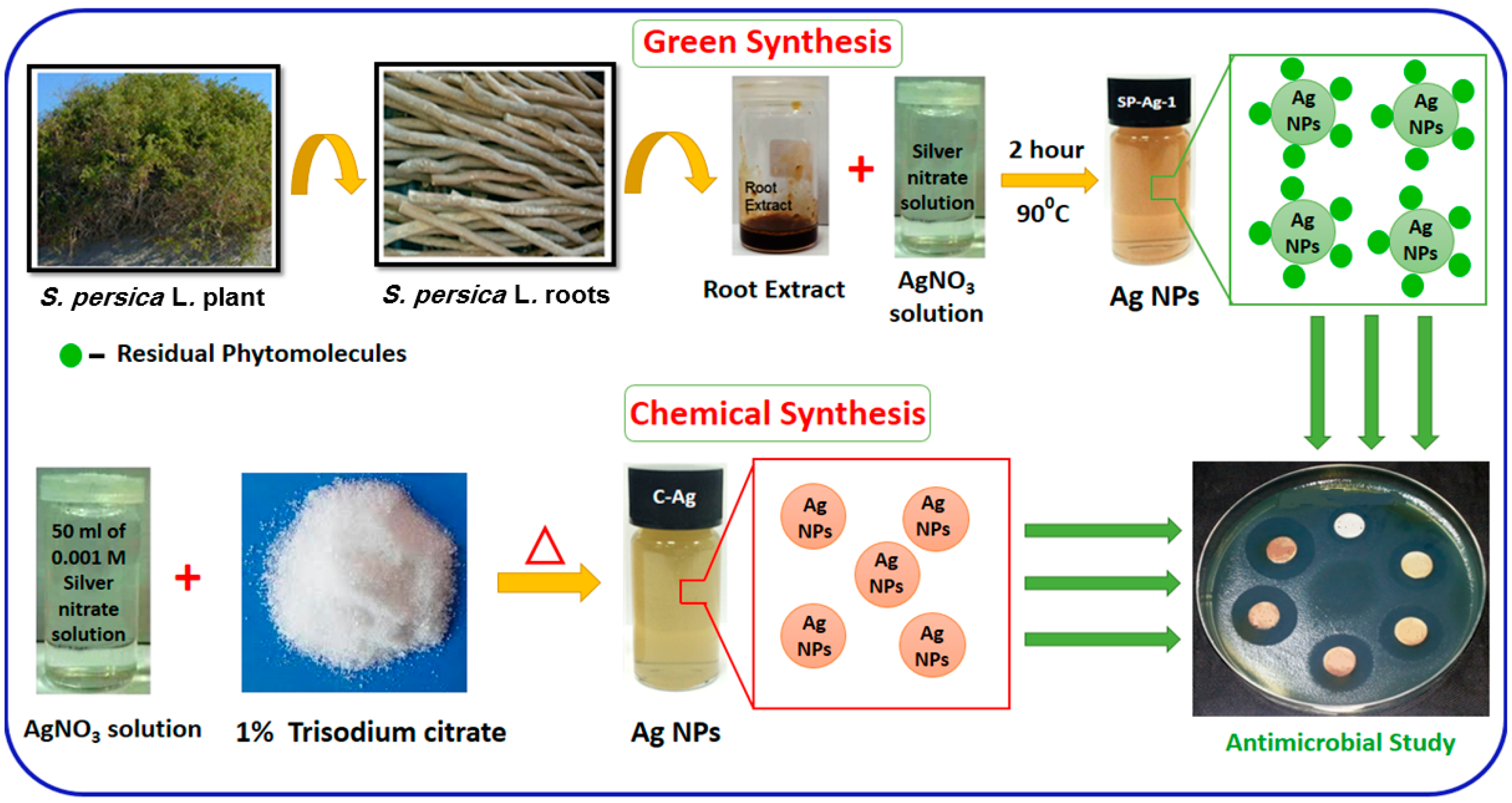

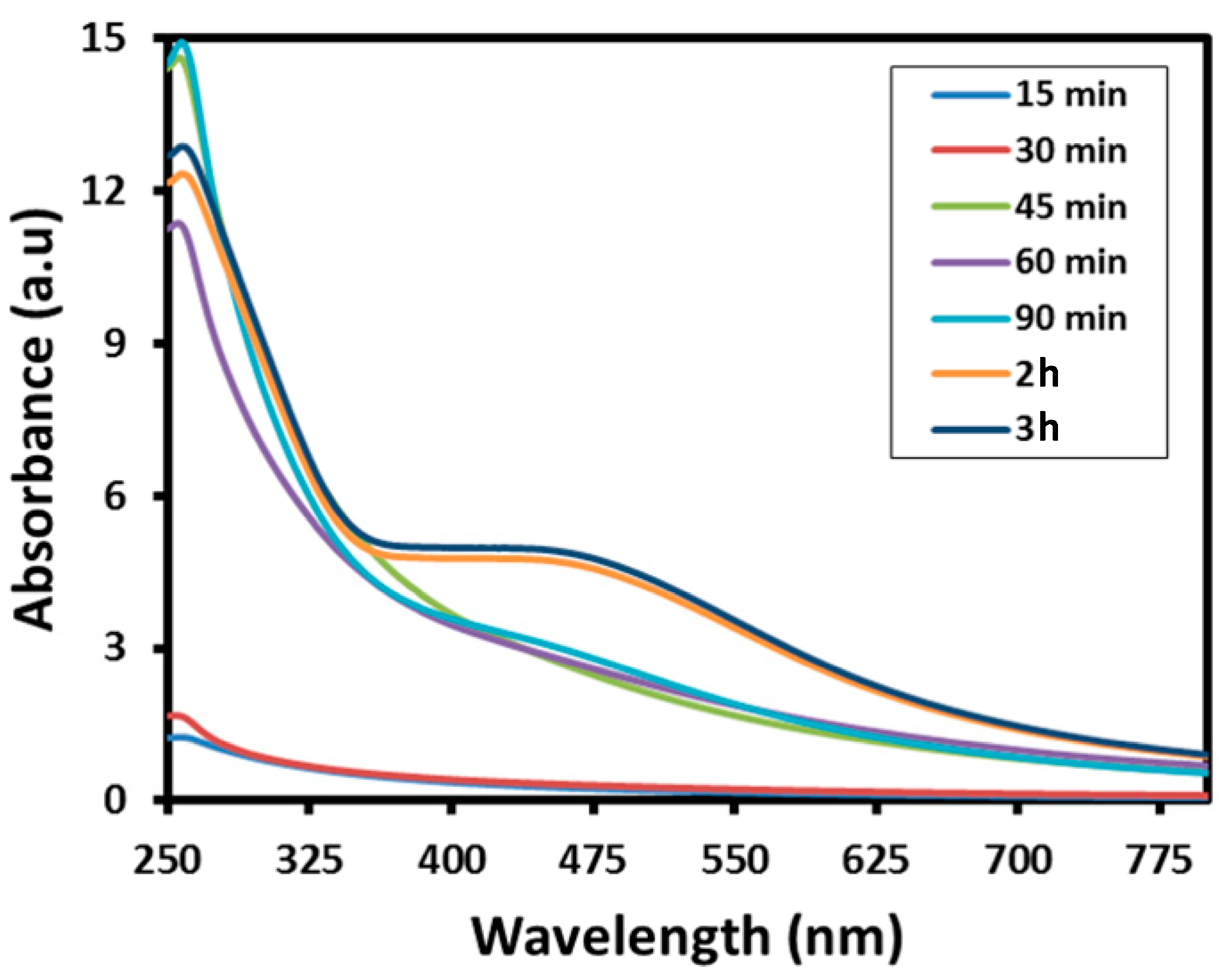
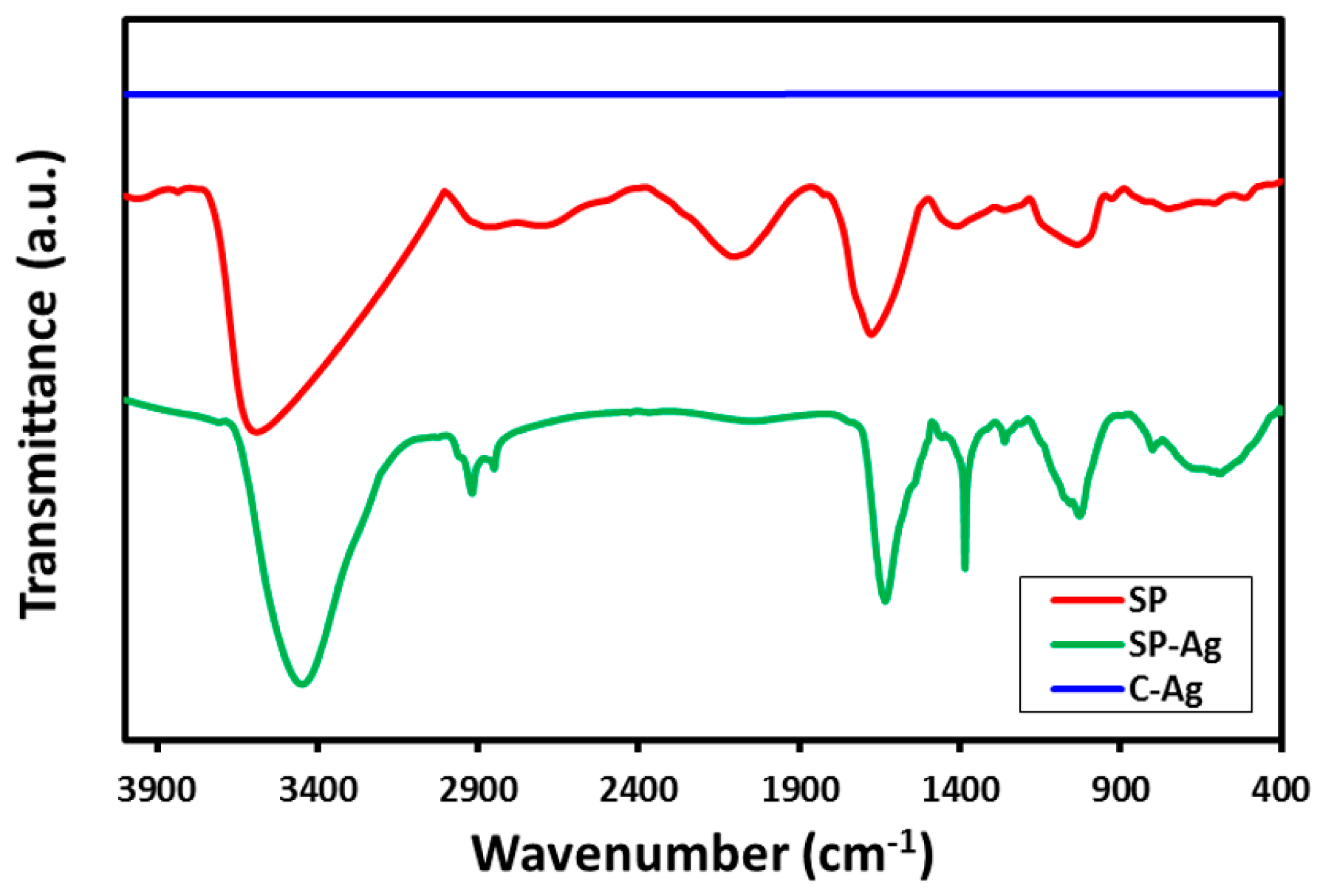

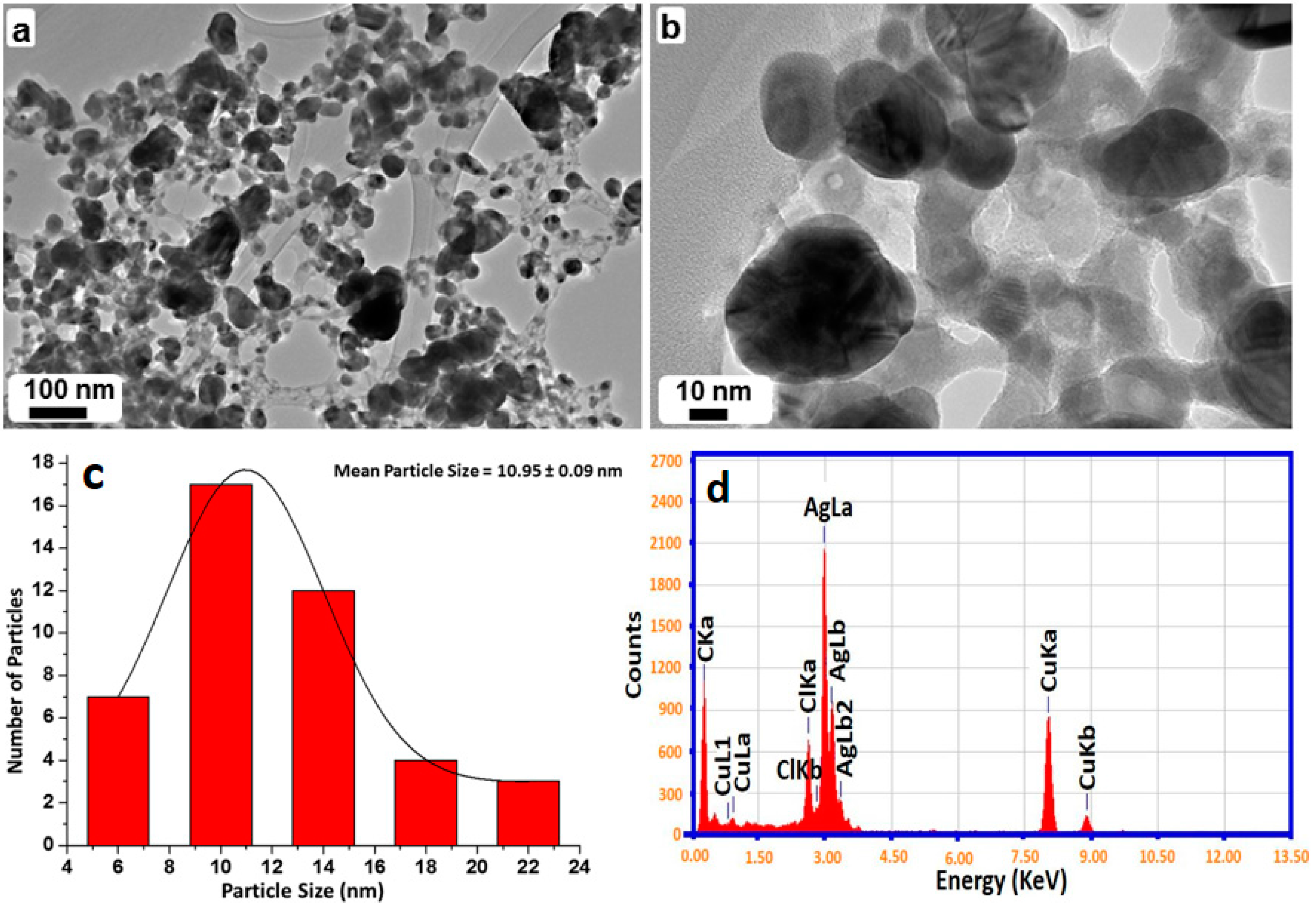
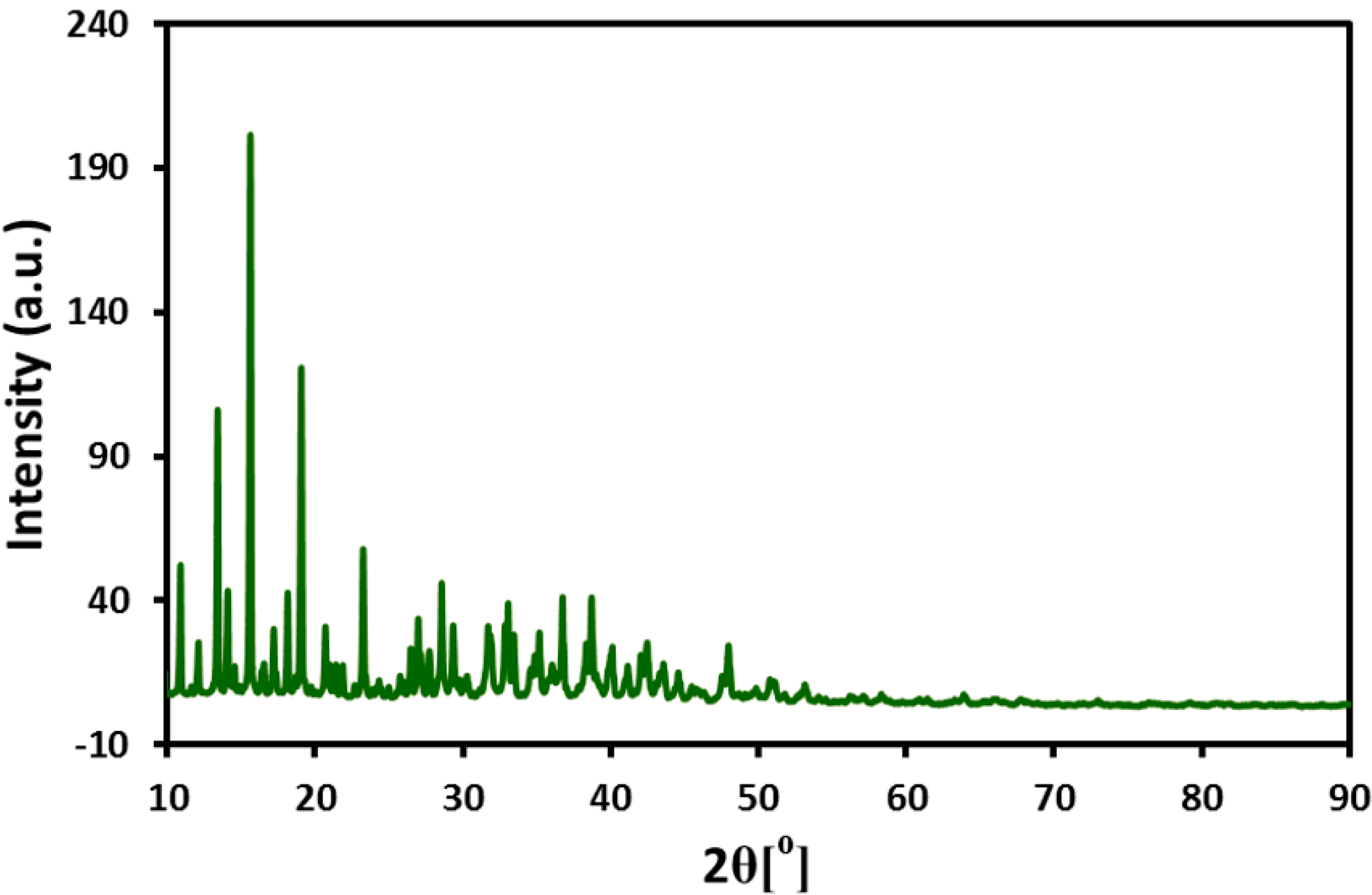



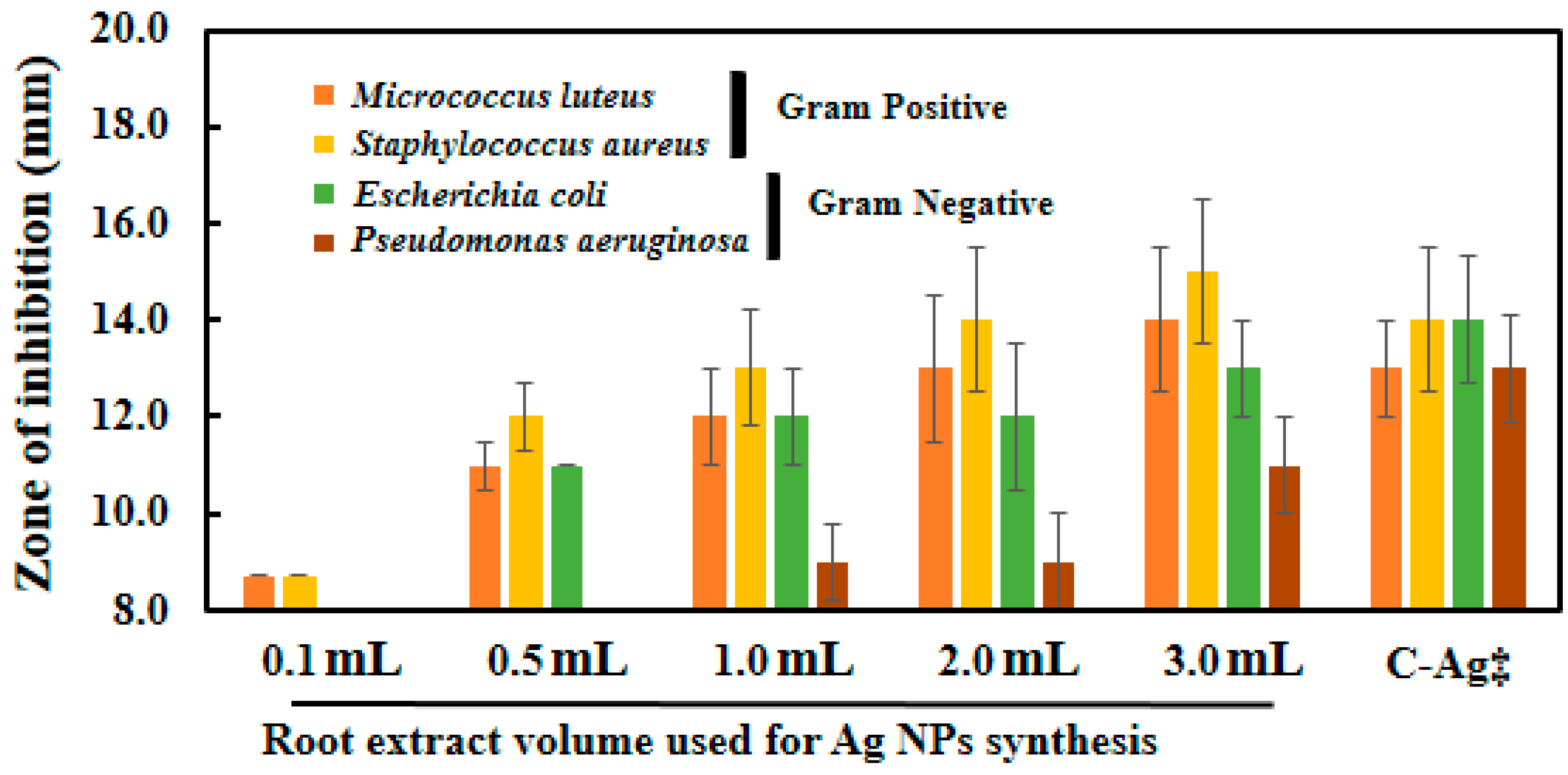
| RE* Volumes used for Ag-NPs Synthesis | Zone of Inhibition (mm) a | |||
|---|---|---|---|---|
| Gram Positive | Gram Negative | |||
| M. luteus | S. aureus | E. coli | P. aeruginosa | |
| RE b | 8 | 8 | 8 | 8 |
| 0.1 mL | 8.7 | 8.7 | 8 | 8 |
| 0.5 mL | 11 | 12 | 11 | 8 |
| 1.0 mL | 12 | 13 | 12 | 9 |
| 2.0 mL | 13 | 14 | 12 | 9 |
| 3.0 mL | 14 | 15 | 13 | 11 |
| C-Ag c | 13 | 14 | 14 | 13 |
© 2016 by the authors. Licensee MDPI, Basel, Switzerland. This article is an open access article distributed under the terms and conditions of the Creative Commons Attribution (CC-BY) license ( http://creativecommons.org/licenses/by/4.0/).
Share and Cite
Shaik, M.R.; Albalawi, G.H.; Khan, S.T.; Khan, M.; Adil, S.F.; Kuniyil, M.; Al-Warthan, A.; Siddiqui, M.R.H.; Alkhathlan, H.Z.; Khan, M. “Miswak” Based Green Synthesis of Silver Nanoparticles: Evaluation and Comparison of Their Microbicidal Activities with the Chemical Synthesis. Molecules 2016, 21, 1478. https://doi.org/10.3390/molecules21111478
Shaik MR, Albalawi GH, Khan ST, Khan M, Adil SF, Kuniyil M, Al-Warthan A, Siddiqui MRH, Alkhathlan HZ, Khan M. “Miswak” Based Green Synthesis of Silver Nanoparticles: Evaluation and Comparison of Their Microbicidal Activities with the Chemical Synthesis. Molecules. 2016; 21(11):1478. https://doi.org/10.3390/molecules21111478
Chicago/Turabian StyleShaik, Mohammed Rafi, Ghadeer H. Albalawi, Shams Tabrez Khan, Merajuddin Khan, Syed Farooq Adil, Mufsir Kuniyil, Abdulrahman Al-Warthan, Mohammed Rafiq H. Siddiqui, Hamad Z. Alkhathlan, and Mujeeb Khan. 2016. "“Miswak” Based Green Synthesis of Silver Nanoparticles: Evaluation and Comparison of Their Microbicidal Activities with the Chemical Synthesis" Molecules 21, no. 11: 1478. https://doi.org/10.3390/molecules21111478
APA StyleShaik, M. R., Albalawi, G. H., Khan, S. T., Khan, M., Adil, S. F., Kuniyil, M., Al-Warthan, A., Siddiqui, M. R. H., Alkhathlan, H. Z., & Khan, M. (2016). “Miswak” Based Green Synthesis of Silver Nanoparticles: Evaluation and Comparison of Their Microbicidal Activities with the Chemical Synthesis. Molecules, 21(11), 1478. https://doi.org/10.3390/molecules21111478











